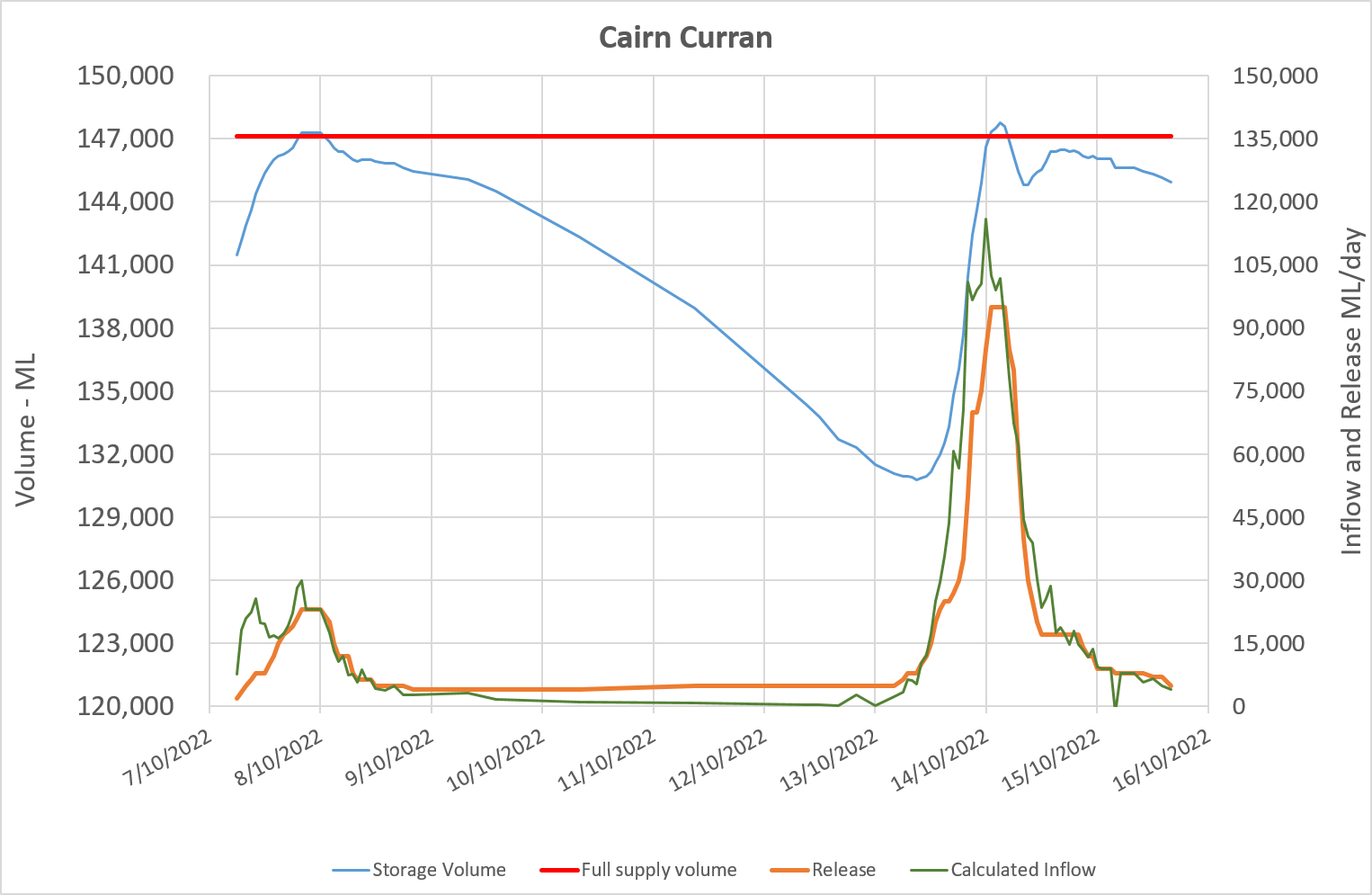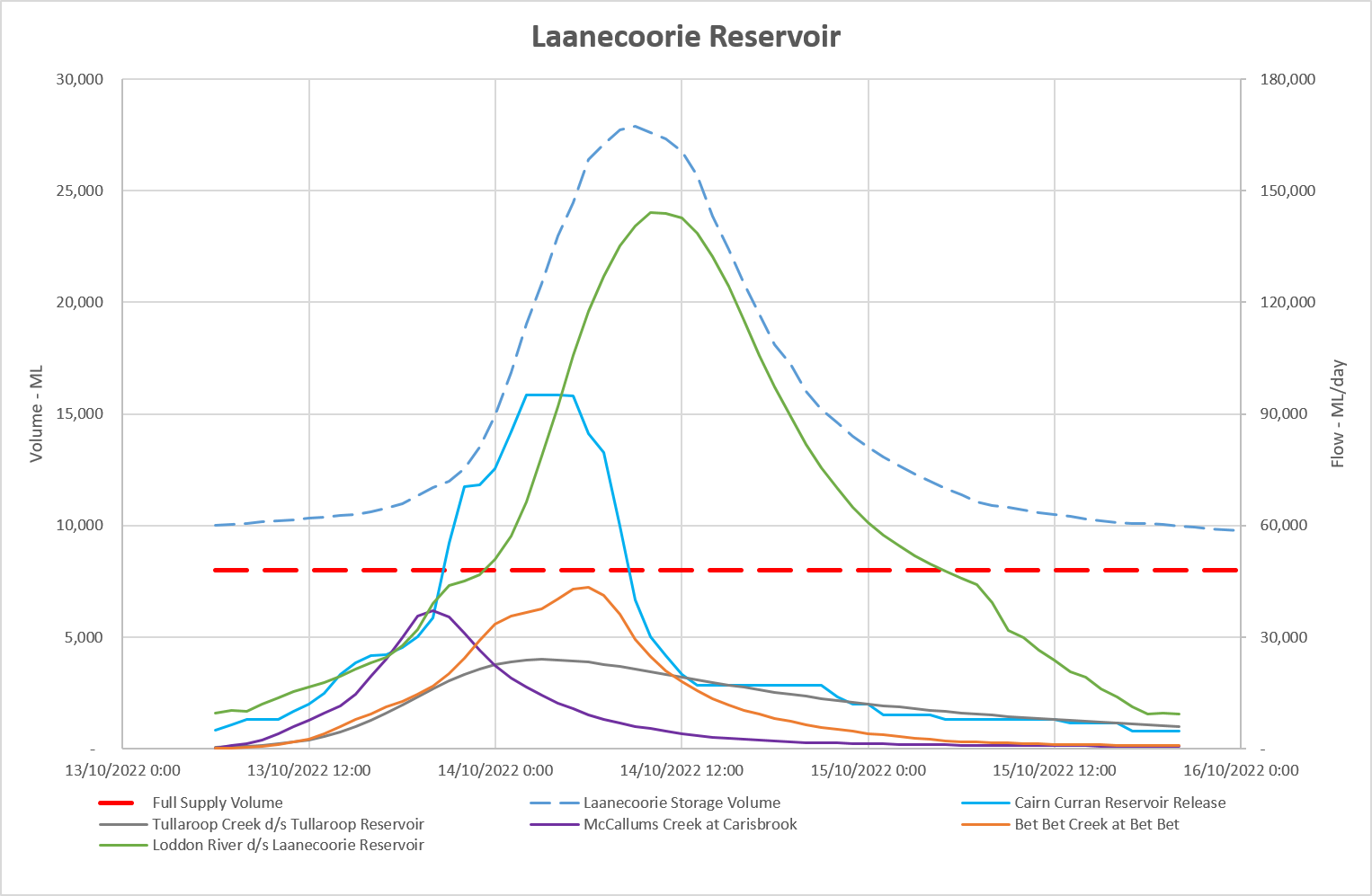How the October 2022 floods at Cairn Curran and Laanecoorie Reservoirs impacted the Loddon River
Climate influences
In September 2022 the Bureau of Meteorology (BOM) declared a La Niña weather pattern for a third consecutive year – increasing the chances of above-average rainfall across the GMW region. This was only the third time an extended La Niña has occurred since records began in 1900.
Victoria’s weather this year has also been influenced by a negative Indian Ocean Dipole, which typically sees above-average winter-spring rainfall in Australia.
The weather patterns we have received have caused a wetter catchment, higher soil moisture content, and minimal water absorption, leading to increased runoff and higher river levels.
Key facts
- Cairn Curran Reservoir initially reached full supply level following a moderate rainfall and subsequent inflow event on the 7 and 8 October 2022.
- GMW initiated a pre-release of water from Cairn Curran following this event at a rate of approximately 5,000 ML/day to create space in the storage. This created approximately 16,350 ML of space prior to the major rainfall event on 13 and 14 October.
- Inflows to Cairn Curran peaked at 116,000 ML/d on 14 October. Releases from Cairn Curran peaked at 95,000 ML/d. Pre-releases before and during the rain event allowed the downstream flow to be reduced by approximately 21,000 ML/d.
- Total inflows over the 24 hour period from 1pm on 13 October 2022 were around 67,000 ML, which is around 45 per cent of the total storage capacity.
- On 13 October 2022 flows from the Bet Bet and McCallums creeks as well as Tullaroop and Cairn Curran reservoirs arrived at Laanecoorie Reservoir.
- The flow downstream of Laanecoorie Reservoir peaked at about 145,000 ML/d on 14 October 2022, about three metres above the major flood level.
Cairn Curran Reservoir
GMW began pre-releasing from Cairn Curran Reservoir through the outlet valve and spillway gates to manage storage levels in early October (Storage Release – orange line). These releases were made to slow the rate of rise and create space ahead of forecast rainfall.
Cairn Curran inflows increased significantly on Friday 7 October 2022 resulting in a “double peak” inflow event (Inflows – green line).
Inflows first peaked at around 25,000 ML/d, and were mitigated by using the space created by the earlier pre-releases. Releases were then increased to just above the major flood level as inflows again rose, peaking at 30,000 ML/d and filling the storage. The room in the storage created by the pre-releases ahead of the peak inflows delayed and reduced the peak of the flood by approximately 5,000 ML/d.
GMW continued pre-releases of approximately 5,000 ML/d to make room in the storage ahead of any further significant rainfall events – creating around 16,350 ML of space (Decline in storage volume - blue line).
As a result of further rainfall, inflows increased significantly on 13 October 2022 resulting in the need to further increase releases to safely pass flows through the storage. The space created by these increased releases was used to keep the downstream flows as low as possible by storing some of the inflow in the reservoir.
Inflows peaked early morning on 14 October 2022 at around 116,000 ML/d. Releases peaked at 95,000 ML/d, well in excess of the major flood level. Careful use of the available space in the storage reduced the peak downstream flows by approximately 21,000 ML/d.
Total inflows over the 24 hour period from 1pm on 13 October were around 67,000 ML, which is around 45 per cent of the total storage capacity. Releases fell back below the minor flood level on 15 October 2022.

A line graph titled Cairn Curran. The date range is 7 to 16 October 2022. The graph provides visual representation of the volume of the Cairn Curran Reservoir in megalitres using the left hand vertical axis. A red line represents full supply level at 147,000 ML, and a blue line represents the fluctuating height of the storage in response to inflows in to the storage. On 8 and 14 October 2022 the volume of the storage exceeded full supply.
The graph also provides a visual representation of the inflows to and releases from Cairn Curran Reservoir in megalitres per day using the right hand vertical axis. A green line represents inflows which peaked to around 30,000 megalitres per day on 7 October 2022 and then peaked again to 116,000 megalitres per day on 14 October 2022. An orange line represents the storage releases in response to the infows. Releases peaked at around 25,000 megalitres per day on 7 October 2022 and then peaked again to 95,000 megalitres per day on 14 October 2022.
Laanecoorie Reservoir
Flows from Cairn Curran Reservoir continued down the Loddon River to Laanecoorie Reservoir.
Laanecoorie Reservoir is a tilt gate storage. This means that once the reservoir level reaches a certain height, the tilt gates open due to the weight of water. Like a fixed crest spillway, flows downstream are governed by the water level in the reservoir.
On 13 October 2022 flows from the Bet Bet and McCallums creeks, as well as from Tullaroop and Cairn Curran reservoirs, arrived at Laanecoorie. The flow downstream of Laanecoorie Reservoir peaked at about 145,000 ML/d on 14 October 2022, about three metres above the major flood level.
River flows in the Loddon system rise and fall very quickly in response to heavy rain. By 17 October 2022, the level downstream of Laanecoorie Reservoir was below moderate flood level.
Once downstream of Laanecoorie Reservoir, flows dispersed across the floodplain and have been slowly moving north towards the Murray River.

A line graph titled Laanecoorie Reservoir. The date range is 13 to 16 October 2022. The graph provides visual representation of the volume of the Laanecoorie Reservoir in megalitres using the left hand vertical axis. A dashed red line represents full supply level at 8,000 ML, and a dashed blue line represents the fluctuating height of the storage in response to inflows in to the storage. The dashed blue line sits above the full supply level at about 10,000 megalitres and then peaks at about 27,000 megalitres on 14 October 2022 before dropping back to just below 10,000 megalitres.
The graph also provides a visual representation of the monitored flows of tributaries both upstream and downstream of Laanecoorie in megalitres per day using the right hand vertical axis:
- A blue line tracks releases from Cairn Curran Reservoir, which peaked at approximately 95,000 megalitres per day on 14 October 2022.
- A grey line tracks the Tullaroop Creek downstream of Tullaroop Reservoir, flows in this creek peaked at approximately 24,000 megalitres per day on 14 October 2022.
- A purple line tracks McCallums Creek at Carisbrook, flows in this creek peaked at approximately 39,000 megalitres per day on 13 October 2022.
- An orange line tracks the Bet Bet Creek at Bet Bet, flows in this creek peaked at approximately 43,000 megalitres per day on 14 October 2022.
- A green line tracks the Loddon River downstream of Laanecoorie Reservoir, flows in this river peaked at approximately 144,000 megalitres per day on 14 October 2022.
Role of GMW storages during floods
GMW’s water storages are designed and operated to provide a secure and safe water supply. They are not specifically for flood mitigation. If there is opportunity, the storages can be operated to reduce the downstream flood peak where possible.
Water storages may provide significant mitigation for small floods and may reduce downstream flooding. However, a storage’s ability to mitigate downstream flows so they remain below flood thresholds reduces as floods become larger